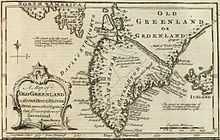Danish colonization of the Americas
| Part of a series on |
| European colonization of the Americas |
|---|
 |
|
|
Denmark and the former
West Indies (1754–1917)
Explorers (mainly Norwegians), scientists, merchants (mainly Danish) and settlers from
Denmark–Norway started colonies on
In 1868, Denmark voted to sell the colony to the United States but their offer was rebuffed. In 1902, Denmark rejected an American purchase offer. On 31 March 1917, the United States finally purchased the islands, which had been in economic decline since the abolition of slavery.
Greenland (1814–present)
Between the years 1605–1607, King Christian IV of Denmark–Norway commissioned three expeditions to Greenland. These expeditions were conducted in order to locate the lost Norse Eastern Settlement as well as to reassert Danish sovereignty over Greenland. The expeditions were largely unsuccessful, partly due to its leaders lacking experience with the arctic ice and difficult weather conditions. Additionally later expeditions were searching on the east coast of Greenland, which was almost inaccessible at the time due to southward-drifting ice. [4] In the 1660s, a polar bear was added to the royal coat of arms. Around this same time Dano-Norwegian ships, joined by ships from various other European countries, began journeying to Greenland to hunt bowhead whales, though no formal recolonization was attempted.

In 1721, the Norwegian
Three

Danish intervention on
The
See also
- Christiansted National Historic Site
- Danish India (Tranquebar)
- Dutch colonization of the Americas
- History of Denmark
- History of Greenland
- History of Norway
- Virgin Islands National Park
- Danish people in Greenland
References
- ^ The Fate of Greenland's Vikings, by Dale Mackenzie Brown, Archaeological Institute of America, February 28, 2000
- ^ a b c d e Marquardt, Ole. "Change and Continuity in Denmark's Greenland Policy" in The Oldenburg Monarchy: An Underestimated Empire?. Verlag Ludwig (Kiel), 2006.
- ISBN 0-7368-0939-2.
- ^ Gosch, C.C.A. Danish Arctic Expeditions, 1605 to 1620. Book I.—The Danish Expeditions to Greenland in 1605, 1606, and 1607; to which is added Captain James Hall's Voyage to Greenland in 1612 London: Hakluyt Society. 1897
- ^ Cranz, David & al. The History of Greenland: including an account of the mission carried on by the United Brethren in that country. Longman, 1820.
- ^ Cavell, Janice. "Historical Evidence and the Eastern Greenland Case Archived 2020-07-29 at the Wayback Machine". Arctic, Vol. 61, No. 4 (Dec. 2008), pp. 433–441.
- ^ Royal Greenland. "Our History Archived 2012-05-26 at the Wayback Machine". Accessed 30 Apr 2012.
